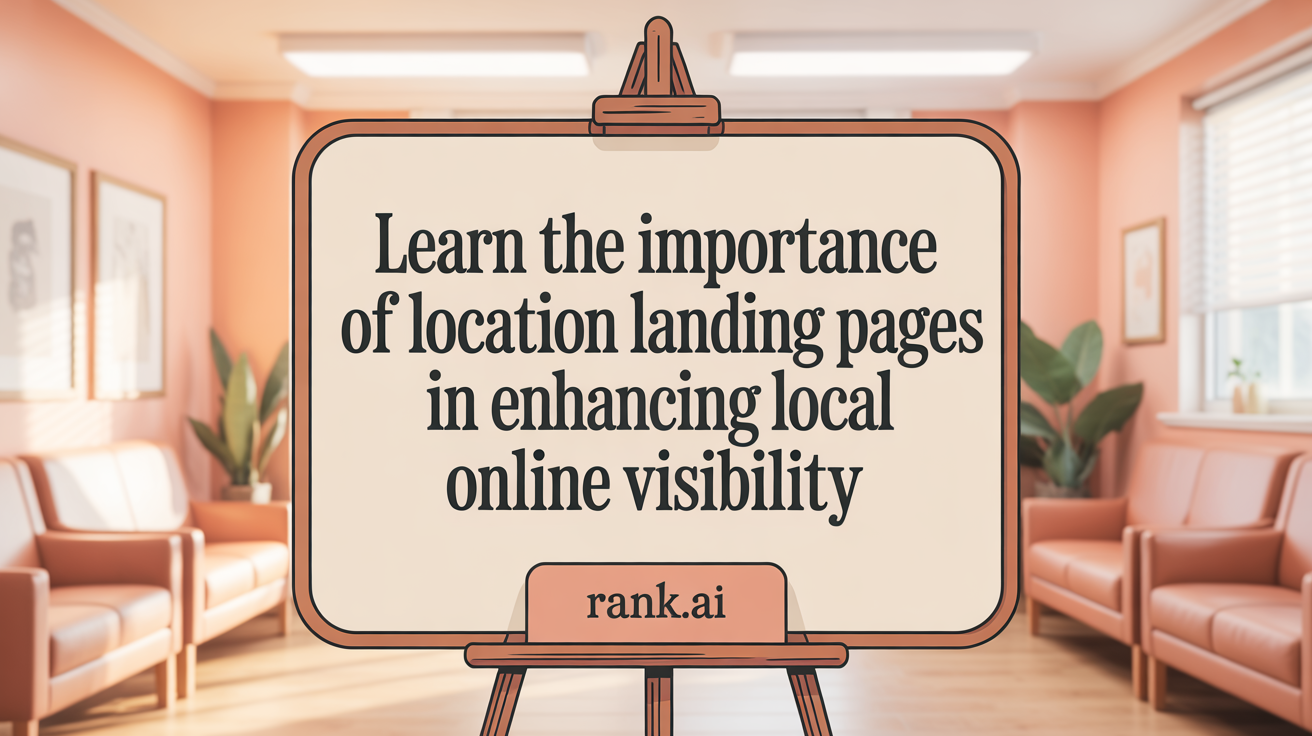Introduction to Location-Based Landing Pages
Location-based landing pages are essential tools for businesses aiming to boost their local search visibility and engage specific geographic markets. By tailoring content and SEO strategies to individual locations, these pages connect companies with nearby customers more effectively than generic pages. This article explores the best practices for crafting location landing pages that elevate local SEO, improve user experience, avoid duplicate content issues, and drive higher conversions.
Understanding Location Landing Pages and Their Role in Local SEO

What is a location landing page and why is it important for local SEO?
A location landing page is a specialized webpage created to spotlight a specific physical location of a business. It includes essential details such as the address, phone number, business hours, and services available at that site. These pages also incorporate localized keywords and interactive elements like maps and reviews to enhance relevance.
In the realm of local SEO, these pages play a crucial role. They help search engines recognize the geographic focus of your business, boosting your chances of appearing in local search results and map listings. For potential customers, location landing pages deliver quick, targeted information, making it easier for them to find and connect with your business nearby.
By tailoring content and optimizing on-page elements for each location, businesses can capture more local traffic and improve their visibility in the competitive local search landscape. Ultimately, well-designed location pages are a vital tool for attracting nearby customers and strengthening your local online presence.
Key Benefits of Location Landing Pages for SEO and Business Growth

What are the benefits of location landing pages for SEO?
Location landing pages are powerful tools to boost your local SEO efforts. They specifically focus on geographic areas where your business operates, making your website more relevant to local searches. This targeted approach helps improve your rankings in Google's local pack and organic search results.
These pages increase your visibility by providing region-specific content that resonates with local audiences. Incorporating local landmarks, community references, and regional keywords makes your business more discoverable to nearby customers.
Another significant advantage is the ability to drive more targeted traffic. When your pages are optimized with relevant keywords like "near me" and specific location terms, they attract users actively seeking your services in that area.
Maintaining consistent NAP (Name, Address, Phone number) information across all your location pages enhances trustworthiness and makes it easier for search engines to verify your business details. This consistency is essential for local search rankings.
Furthermore, well-crafted location pages facilitate the generation of local backlinks and reviews. Positive reviews and backlinks from local sources signal your credibility and authority, which are vital ranking factors.
Overall, these pages not only improve your visibility in local searches but also help you connect more effectively with nearby prospects, fostering business growth through heightened engagement.
| SEO Advantage | Description | Impact |
|---|---|---|
| Better local rankings | Targets specific areas, boosting presence in local search results. | Improved visibility in Google Maps and local queries. |
| Increased local visibility | Tailored content and keywords enhance relevance for local users. | Higher chances of appearing in local 3-Pack results. |
| Targeted traffic and clicks | Attracts users searching for local services or products. | More visitors and potential customers. |
| NAP consistency | Ensures accurate business info across all pages. | Builds trust with search engines and customers. |
| Local backlinks and reviews | Encourages local engagement and credibility. | Strengthens SEO signals and enhances ranking potential. |
Creating dedicated, optimized location landing pages is a smart SEO strategy that helps your business stand out in local online searches.
Crafting Effective Local Landing Pages: Essential Elements and SEO Techniques

How do you create an effective local landing page for SEO?
Creating a strong local landing page involves carefully blending content, technical SEO, and user experience considerations. Start by integrating local keywords naturally within your content, including city or region names, neighborhood terms, and relevant service or product keywords. Ensuring your business details—Name, Address, and Phone Number (NAP)—are accurate, consistent, and prominently displayed helps search engines verify your local presence.
Adding schema markup and embedded maps not only improves your page’s relevance but also enhances visibility in local search results and Google’s Map Pack. The page must be mobile-optimized with fast load times to accommodate users browsing on smartphones, which dominate local searches.
Optimize meta titles, descriptions, and URL structures by including location-specific keywords. Keep URLs short, descriptive, and relevant to aid both users and search engines. Use compelling headlines that highlight your USPs and speak directly to local needs.
Incorporate community-specific content, such as references to local landmarks, community organizations, or region-specific promotions, to personalize the page.
Visual content like original images and videos of your location, team, or local events boost engagement and trust. Properly tagged alt texts with local keywords improve image SEO.
Finally, implement strategic internal links to your other relevant pages and external links to reputable local sources. Building trust with reviews and testimonials from local customers, and securing backlinks from local websites, further elevates your SEO efforts. Regular testing and optimization—through A/B testing and analytics—ensure your landing page continues to perform effectively and adapts to evolving local search behaviors.
Optimizing URL Structure and Schema Markup for Local SEO Success

What are the best practices for structuring URLs and using schema markup on local landing pages?
Creating effective URLs for local landing pages starts with clarity and relevance. Use clean, descriptive, and static URLs that include local keywords such as city or neighborhood names. For example, www.example.com/los-angeles/plastic-surgery-center clearly indicates the location and service.
Consistency is crucial. Maintain a uniform URL structure across all location pages to aid navigation and indexing by search engines. Separating words with hyphens enhances readability, both for users and SEO algorithms. Avoid dynamic parameters, session IDs, or extraneous numbers which can dilute local relevance.
Implementing LocalBusiness schema markup enhances the visibility of your business in local search results. This structured data provides detailed business information like the name, address, phone number, hours of operation, and more, directly in search snippets.
Ensure that the information embedded within the schema matches the website content and your Google Business Profile. Accurate details build trust and improve local rankings.
Validation tools such as Google’s Rich Results Test or Schema Markup Validator help verify the correctness of your schema markup. Proper setup ensures your business details are correctly displayed in search results, maps, and voice queries.
Supporting elements like embedded Google Maps, customer reviews, and authentic regional imagery further reinforce your local presence. These additions not only attract clicks but also foster credibility.
By carefully structuring URLs and implementing precise schema markup, your local landing pages will achieve better visibility, higher click-through rates, and enhanced trustworthiness within your target community.
Creating Engaging Local Content to Boost Visibility and Interaction

How can content creation improve engagement and visibility in local search results?
Content creation plays a crucial role in enhancing a business's presence in local search results. By developing hyperlocal, community-focused content, businesses can connect more deeply with local audiences. Examples include neighborhood guides, detailed local event recaps, and testimonials from nearby customers. These types of content not only provide value but also signal relevance to search engines.
Incorporating local keywords within content is essential. Using terms tied to specific neighborhoods, landmarks, streets, or regional service areas helps search engines understand the business’s local context. Structured data markup further amplifies this relevance, increasing the chance of features like rich snippets or prominent placement in local packs.
Regularly updating the website with fresh images and videos demonstrates activity and reliability. Showcasing new projects, community involvement, or seasonal updates keeps the content lively and engaging. Visual content resonates more with users, encouraging shares and interactions.
Leveraging and maintaining Google Business Profiles, along with consistent citations across local directories, ensures that contact details, hours, and other vital information remain accurate. This consistency boosts credibility and trustworthiness, which are vital for local SEO.
Encouraging reviews and engaging with the community through social proof enhances credibility. Positive reviews increase user trust and influence search rankings. Sharing customer testimonials and community stories on the website and social channels not only improves engagement but also signals to search engines that the business is active and popular locally.
In summary, creating targeted, localized content that is regularly refreshed, visually appealing, and tied to the community significantly boosts visibility in local search results and encourages more meaningful user interactions.
Design and User Experience Strategies for Local Landing Pages
What strategies can improve design and user experience on local landing pages?
Enhancing the design and usability of local landing pages is crucial for attracting and converting local visitors. One effective approach is developing dedicated, unique pages for each location that include localized content, community references, and region-specific keywords. This not only improves relevance but also differentiates each page from others.
Ensuring mobile responsiveness is a top priority, as most local searches happen on smartphones. Pages should load quickly on all devices to minimize user frustration and bounce rates. This involves optimizing images, leveraging browser caching, and minimizing code bloat.
Incorporating high-quality, localized visuals—such as original photos of storefronts, staff, and community landmarks—creates a personal connection with visitors and increases trust. These images should have geo-specific alt text to boost SEO.
Clear, prominent calls-to-action (CTAs) tailored to the local audience, such as "Get Directions," "Book an Appointment," or "Browse Our Local Products," guide users towards the next step in their journey. Embedding Google Maps with accurate location markers makes it easier for visitors to find your physical store or office.
Displaying consistent NAP (Name, Address, Phone Number) information across the page and throughout the site reinforces credibility and supports local SEO efforts. Internal links to related services or other location pages help users navigate more efficiently and improve site authority.
Adding social proof through customer reviews, testimonials, and certifications can significantly boost trust and conversions. Using schema markup for reviews and local business data enhances the chances of rich snippets in search results.
Overall, a well-designed local landing page harmonizes visual appeal, technical optimization, and persuasive content, providing potential customers with a memorable and user-friendly experience that encourages engagement and local business growth.
Avoiding Duplicate Content Penalties While Targeting Multiple Locations
Creating distinct, locally relevant content for each location-specific landing page is crucial to avoid duplicate content issues. Tailor narratives to highlight specific services, local landmarks, community involvement, or regional events. This approach ensures each page resonates uniquely with its target audience and search engines.
Incorporate neighborhood or landmark mentions naturally within titles, meta descriptions, headers, and the main body of your content. For example, referencing nearby parks, streets, or well-known community organizations adds local flavor and distinguishes pages.
Employ canonical tags to signal the primary version of similar pages, preventing search engines from penalizing duplicate content. Use hreflang tags for regional variations, especially if your site targets different language speakers or regions, to clarify the geographic focus.
Differentiating page elements like titles and meta descriptions is another effective strategy. Unique, keyword-rich titles and compelling descriptions help pages stand out in search results and reduce keyword cannibalization.
Regular audits using SEO tools are essential to identify and clean up duplicate content across your location pages. Remove or update duplicated sections and ensure each page maintains its unique value.
Limit the number of location pages to those that serve substantial audiences or strategic regions. Excessive pages can dilute your site’s authority and create maintenance challenges.
By implementing these strategies, your website can rank well across multiple locations without risking penalties for duplicate content. Rather than copying content, focus on authentic, specific local information that builds trust and relevance in search results.
Techniques to Maximize Conversions on Local Landing Pages
What methods increase conversions and attract local customers through landing pages?
Maximizing conversions on local landing pages involves several critical techniques tailored to engage community-specific audiences effectively. One of the most effective strategies is ensuring consistency between advertising messages and landing page content. When local ads highlight specific promotions, services, or landmarks, the landing page should mirror these elements to create a seamless user experience.
Designing a compelling headline coupled with clear benefits above the fold captures attention immediately. This section should include a strong call-to-action (CTA), such as 'Get Directions,' 'Book Now,' or 'Contact Us,' making it easy for visitors to take the next step.
Visual content plays a vital role in building trust. Incorporating high-quality images of the local premises, team members, or community involvement enhances authenticity. Adding social proof, like customer reviews and testimonials from local clients, further boosts credibility.
To prevent visitor distraction, remove unnecessary navigation menus and focus on guiding users toward conversion goals. Ensuring fast page load times and mobile responsiveness improves usability and reduces bounce rates.
Finally, ongoing optimization through A/B testing and utilizing proven layout templates allows businesses to refine their pages continuously. By analyzing performance data, they can identify which elements drive higher engagement and adjust accordingly.
Overall, these tactics—tailored messaging, engaging visuals, clear CTAs, and data-driven refinement—are essential for converting local traffic into loyal customers through highly effective landing pages.
Integrating Google Business Profiles and Local Citations for Enhanced Visibility
Aligning Google Business Profiles with Landing Pages
Creating dedicated landing pages for each location and aligning them with corresponding Google My Business (GMB) profiles ensures consistency and boosts local SEO. This helps search engines associate the page content with the correct physical location, improving visibility in local search results.
Ensuring Accurate and Consistent NAP
Consistent Name, Address, and Phone Number (NAP) details across all directories, your website, and GMB profiles are crucial. Discrepancies can confuse search engines and reduce rankings. Regularly auditing NAP details to maintain accuracy supports better local search performance.
Leveraging Reviews and Responding to Feedback
Customer reviews significantly influence local SEO and consumer trust. Actively encourage positive reviews and respond promptly to both positive and negative feedback. Responding shows engagement and builds credibility, which enhances your EEAT (Expertise, Authority, Trustworthiness) signals.
Building Local Citations on Directories and Community Sites
Listing your business on reputable local directories and community websites with consistent NAP information increases your local relevance and search authority. These citations serve as backlinks and reinforce your presence in the local community.
Enhancing Map Pack Presence
Optimized GMB profiles with accurate information, reviews, high-quality images, and active engagement improve your chances of appearing in the Google Map Pack. Embedding maps on your location pages and ensuring they match your business details strengthens search engine trust.
Driving Trust and Credibility through EEAT Signals
Displaying reviews, certifications, industry awards, and community involvement enhances your authority and trustworthiness. Personal touches like staff bios and local testimonials on your landing pages also contribute positively, encouraging conversions.
By effectively integrating your Google Business Profile with your local SEO landing pages and maintaining consistent citations, your business can increase local visibility, attract more nearby customers, and build lasting community trust.
Advanced Strategies: Using Analytics, IP Targeting, and Retargeting
Tracking Impressions, Clicks, and Conversions Per Location
Implementing detailed analytics allows local businesses to measure how well their location-specific pages are performing. By tracking impressions, clicks, and conversions, companies gain insights into which locations attract the most visitors and generate leads. Using tools like Google Analytics and Google Search Console helps monitor these metrics at a granular level, enabling precise adjustments.
Using IP-Based Content Personalization Tools
IP geolocation technology can personalize website content based on the visitor’s physical location. This ensures that potential customers see information most relevant to their area, such as local promotions, service availability, and nearby store locations. Implementing IP-based personalization enhances user experience and increases the likelihood of conversions.
Incorporating Bitly and Other Tracking Links
Utilizing URL shorteners like Bitly not only makes links more manageable but also provides valuable data on click sources and engagement. By embedding trackable links within local ads, emails, or social media posts, businesses can measure the effectiveness of regional campaigns and optimize accordingly.
Retargeting Visitors with Localized Ads and Offers
Retargeting enables businesses to reconnect with visitors who previously showed interest but did not convert. Using location data, you can serve personalized ads or special offers specific to that user’s region. This strategy increases brand recall and encourages revisiting the site or nearby physical stores.
Continuous Optimization Based on Analytics Data
Regular analysis of gathered data helps identify trends and areas needing improvement. A/B testing different content, headlines, or offers within location pages can refine strategies. Ongoing optimization ensures that local SEO efforts remain effective, maximizing both engagement and conversions.
Maintaining and Scaling Location Landing Pages for Long-term SEO Success
Why are regular updates and audits crucial for location landing pages?
Regularly reviewing and refreshing content on your local SEO pages ensures they stay relevant and accurate. Keeping business details, hours, and contact info current helps improve user trust and search rankings. Conducting periodic audits also identifies outdated content or technical issues such as broken links, which can hinder visibility.
How should you maintain XML sitemaps and manage redirects?
Keeping your XML sitemap up to date with new or modified location pages is essential for search engines to crawl your site efficiently. Implementing 301 redirects when reorganizing or removing pages preserves link equity and prevents broken links, ensuring a smooth user experience and sustained SEO value.
Is using templates for business hours, reviews, and certifications beneficial?
Yes, templates streamline the creation and updating process for consistent elements like business hours, reviews, and industry certifications. This approach maintains uniformity across multiple locations while saving time and reducing errors.
Why should you limit the number of location pages?
Creating too many pages—beyond 20% of your total site—can dilute your site’s authority and create management challenges. Focus on high-impact locations that matter most to your target audience, ensuring each page remains high-quality and unique.
How to balance uniqueness and consistency across pages?
While each location page should have personalized content reflecting local landmarks, community involvement, or customer reviews, maintaining a consistent structure and branding builds trust and clarity. Use tailored local content but standardized templates for core elements like contact info and service descriptions.
What is the best way to plan the rollout of new location pages?
Develop a strategic rollout plan that includes comprehensive local keyword research, content creation, and URL structuring. Launch new pages gradually, monitor performance, and optimize based on user engagement and search data. This structured approach helps scale your local SEO efforts effectively.
Building and maintaining location landing pages over time requires disciplined updates, strategic planning, and a focus on local relevance. Adhering to these practices ensures your business remains visible, trusted, and competitive in local search results.
Conclusion: Mastering Location-Based Landing Pages for Local SEO
Location-based landing pages serve as powerful assets in a business's local SEO arsenal, enabling targeted geographic engagement and improved search rankings. By implementing best practices—from crafting unique, localized content and optimizing URL structures with schema markup to enhancing design and user experience tailored for local audiences—businesses can stand out in competitive local markets. Avoiding duplicate content and focusing on conversion-driven designs ensures sustainable growth and higher ROI. Coupled with continuous optimization, integration with Google Business Profiles, and leveraging analytics-driven personalization, these strategies collectively elevate a brand’s local presence and drive foot traffic and sales. Embracing these comprehensive approaches empowers businesses to connect authentically with communities and dominate local search results.
References
- How to Create Local SEO Landing Pages That Work (+ Examples)
- How Location landing Pages Improve Local SEO - Uberall
- 10 Powerful Tips to Create Local Landing Pages
- Location Landing Pages: 6 Crucial Elements Of Local Visibility - Ahrefs
- How to Create Landing Pages for Location-Based Targeting - Bitly
- Creating Local Landing Pages for Multi-Location Brands | GPO
- How to Create Content for Local Landing Pages for SEO - AirOps



